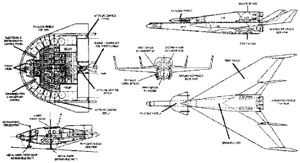
Home - Search - Browse - Alphabetic Index: 0- 1- 2- 3- 4- 5- 6- 7- 8- 9
A- B- C- D- E- F- G- H- I- J- K- L- M- N- O- P- Q- R- S- T- U- V- W- X- Y- Z
NAA RTTOCV
 NAA Orbital Transfer Credit: Mark Wade |
Status: Design 1963. Payload: 11,340 kg (25,000 lb). Gross mass: 548,847 kg (1,210,000 lb). Height: 32.90 m (107.90 ft). Apogee: 185 km (114 mi).
Two crew plus ten passengers, or a mix of passengers and cargo, could be carried. The saucer-shaped body merged aft into a thick planform with vertical stabilizers along the base. Yaw thrusters were at the tops of the vertical stabilizers, the pitch thrusters above the engine bay, and the roll thrusters at the roots of the stabilizers. A single gimbaled engine provided thrust for orbital maneuvers. Crew access was via a 1.2-m-diameter hatch at the top of the saucer. The pilot used a periscope for forward vision during landing. Horizontal landing was on skid main gear and a wheeled nose gear, as on the same company's X-15.
The sled-launched rocketplane's booster was 32.9 meters long and would have been powered by a single F-1 and two H-1 kerosene/LOX engines plus turbojets for return to base. The winged second stage was mounted on top of the booster and would have used three liquid oxygen/hydrogen J-2 engines. This fully reusable system would have had a gross liftoff weight of 548,847 kg.
Family: Lenticular Vehicles, orbital launch vehicle, Sled-Launched, Spaceplane, US Rocketplanes, Winged. Country: USA. Launch Vehicles: NAA RTTOCV. Agency: North American. Bibliography: 44.
 | Reusable Ten Ton Orb Credit: NASA |
Back to top of page
Home - Search - Browse - Alphabetic Index: 0- 1- 2- 3- 4- 5- 6- 7- 8- 9
A- B- C- D- E- F- G- H- I- J- K- L- M- N- O- P- Q- R- S- T- U- V- W- X- Y- Z
© 1997-2019 Mark Wade - Contact
© / Conditions for Use